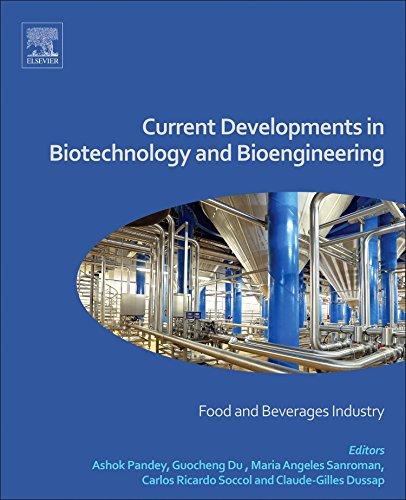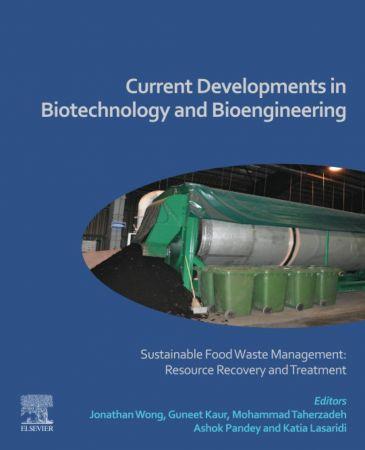https://ebookmass.com/product/current-developments-inbiotechnology-and-bioengineering-food-and-beveragesindustry-1st-edition-ashok-pandey/
Instant digital products (PDF, ePub, MOBI) ready for you
Download now and discover formats that fit your needs...
Current Developments in Biotechnology and Bioengineering: Advances in Composting and Vermicomposting Technology
Ashok Pandey
https://ebookmass.com/product/current-developments-in-biotechnologyand-bioengineering-advances-in-composting-and-vermicompostingtechnology-ashok-pandey/ ebookmass.com
Current Developments in Biotechnology and Bioengineering. Production, Isolation and Purification of Industrial Products 1st Edition Ashok Pandey
https://ebookmass.com/product/current-developments-in-biotechnologyand-bioengineering-production-isolation-and-purification-ofindustrial-products-1st-edition-ashok-pandey/ ebookmass.com
Current Developments in Biotechnology and Bioengineering: Sustainable Food Waste Management: Resource Recovery and Treatment Jonathan Wong
https://ebookmass.com/product/current-developments-in-biotechnologyand-bioengineering-sustainable-food-waste-management-resourcerecovery-and-treatment-jonathan-wong/ ebookmass.com
The Lies I Tell Julie Clark
https://ebookmass.com/product/the-lies-i-tell-julie-clark/
ebookmass.com
CurrentDevelopments inBiotechnologyand Bioengineering
FoodandBeveragesIndustry
Editedby
AshokPandey,MariaA ´ ngelesSanroma ´ n,
GuochengDu,CarlosRicardoSoccol,
Claude-GillesDussap
A.C.GschaedlerMathis CentrodeInvestigaciónyAsistenciaenTecnologíay DiseñodelEstadodeJalisco,Zapopan,Mexico
V.K.Joshi UHF,Solan,HimachalPradesh,India
Z.Kohajdová SlovakUniversityofTechnologyinBratislava,FacultyofChemical andFoodTechnology,Bratislava,Slovakia
A.A.Koutinas UniversityofPatras,Rio,Patras,Achaia,Greece
A.Lebert UniversitéClermontAuvergne,UniversitéBlaisePascal,InstitutPascal, Clermont-Ferrand,France
E.Ledesma UniversityofOviedo,Oviedo,Spain
Q.Li JiangnanUniversity,Wuxi,China
C.Liu JiangnanUniversity,Wuxi,China
A.B.P.Medeiros FederalUniversityofParana,Curitiba,Brazil
A.Mendes-Faia UniversityofTrás-os-MontesandAltoDouro,VilaReal, Portugal;BioISI,Biosystems&IntegrativeSciencesInstitute,Lisboa,Portugal
A.Mendes-Ferreira UniversityofTrás-os-MontesandAltoDouro,VilaReal, Portugal;BioISI,Biosystems&IntegrativeSciencesInstitute,Lisboa,Portugal
A.B.Moldes UniversityofVigo,Vigo Pontevedra,Spain
J.M.Oliveira UniversityofMinho,Braga,Portugal
J.M.Oteiza CenterforResearchandTechnicalAssistancetoIndustry(CIATIAC), Neuquén,Argentina
L.Pastrana InternationalIberianNanotechnologyLaboratory,Braga,Portugal
A.P.Pereira UniversityofTrás-os-MontesandAltoDouro,VilaReal, Portugal;PolytechnicInstituteofBragança,Bragança,Portugal
L.Pereira UniversityofVigo,Ourense,Spain;UniversityofTurin,Turin,Italy
J.R.Piggott FormerlyUniversityofStrathclyde,Glasgow,Scotland
L.Poughon UniversitéClermontAuvergne,UniversitéBlaisePascal,InstitutPascal, Clermont-Ferrand,France
M.Rendueles UniversityofOviedo,Oviedo,Spain
I.RodríguezAmado UniversityofVigo,Ourense,Spain
M.Y.RodriguezCaturla UniversityofCampinas,Campinas,SP,Brazil
M.L.Rúa UniversityofVigo,Ourense,Spain
M.A.Sanromán UniversityofVigo,Vigo,Spain
A.S.Sant’Ana UniversityofCampinas,Campinas,SP,Brazil
N.N.Shah InstituteofChemicalTechnology,Mumbai,India
S.Sharma UHF,Solan,HimachalPradesh,India
R.S.Singhal InstituteofChemicalTechnology,Mumbai,India
C.R.Soccol FederalUniversityofParana,Curitiba,Brazil
K.Tang JiangnanUniversity,Wuxi,China
A.D.Thakur ShooliniUniversity,Solan,HimachalPradesh,India
R.Troncoso UniversityofVigo,Ourense,Spain
X.Vecino UniversityofVigo,Vigo Pontevedra,Spain
J.Wang JiangnanUniversity,Wuxi,China
GuochengDu
ProfessorGuochengDuisthedeanoftheSchoolof Biotechnology,JiangnanUniversity,China.Heisa DistinguishedProfessoroftheChangjiangScholars,Ministry ofEducation,China.Hiscurrentmainresearchfocusison bioprocessengineeringandmetabolicengineering.Hehas about200publicationsandcommunications,whichinclude 52patents,8books,160originalandreviewpapers,among others.HewontwosecondprizesoftheStateScienceand TechnologyAwardin2006and2012,respectively.Hehas beenconferredanhonorarydoctoratefromJiangnan University,China.ProfessorDuisdeputydirectorofthe CommitteeofBiochemicalEngineeringModelingand Control,ChineseSocietyforMicrobiology,anddeputydirectoroftheBeerBranch,ChinaAlcoholicDrinksIndustry Association.Heisanassociateeditorofthe Journalofthe ScienceofFoodandAgriculture andaneditorialboard memberof BioresourceTechnology.
CarlosRicardoSoccol


ProfessorCarlosRicardoSoccolistheresearchgroupleader oftheDepartmentofBioprocessesEngineeringand BiotechnologyattheFederalUniversityofParana ´ .Professor Soccolhasexperienceinfoodbioprocessing,especiallyinthe areasofenzymes,industrialbioprocesses,nutraceuticalsand functionalfoods,appliedmicrobiology,andfermentation technology.Theresearchcarriedouttodatehascredited himwith1083publications,includingpatents(65),books (19),bookchapters(116),originalpapers(311),andresearch communicationsinconferences/symposia(572).His researcharticleshavesofarbeencited7585times(Scopus database),withan h indexof41.Ithasalsoledtothesuccessfulsupervisionof54PhDstudents,106Master’sstudents,and16postdoctoralstudents. In2001,hewasaProfessorHDRinAgri-FoodsBiotechnologyatAix MarseilleUniversity, Marseille,France.HewasaVisitingProfessoratE ´ colePolytechniqueFe ´ de ´ raledeLausanne, Switzerland(2009),Universite ´ Lille1,France(2014),andUniversite ´ BlaisePascal,Clermont Ferrand,France(2015).Hereceivedseveralnationalandinternationalawards,includingthe ScienceandTechnologyAwardoftheGovernmentofParana ´ (1996);BestScientific AchievementoftheYear2001fromtheMinistryofSugarofCuba(MINAZ);Scopus/Elsevier Award(2009);Dr.HonorisCausa,Universite ´ BlaisePascal,France(2010);Outstanding Scientistatthe5thInternationalConferenceonIndustrialBioprocesses,Taipei,Taiwan;
HenriNestle ´ AwardfromNestle ´ ,Brazil(2014);andMedalofMeritfromtheCREA-PR,Brazil (2016).Since2014,ProfessorSoccolhasbeenamemberoftheBrazilianAcademyof Sciences.Hehasoccupiedthepositionofeditorofthe BrazilianArchivesofBiologyand Technology from1997to2015.HealsoholdsthepositionofScientistIAoftheCNPq,Brazil. Heisatechnicalandscientificconsultantforseveralcompaniesandagenciesandan editorialmemberofseveralscientificjournals.
Claude-GillesDussap
ProfessorClaude-GillesDussapgraduatedinchemical engineeringfromtheUniversityofToulousein1978.He didhisPhDworkintheChemicalandBiochemical EngineeringDepartment,focusingonthedevelopmentof bioreactorsattheUniversite ´ BlaisePascal(ClermontFerrand).HeiscurrentlyheadoftheteamChemicaland BiochemicalEngineeringattheInstitutPascal(Universite ´ BlaisePascal CNRS).Hehasbeenmuchinvolvedinthe analysisoftherelationshipsthatexistbetweenthephysiologicalresponsesofmicroorganismsandthebioreactor environment.Thisincludesinsightfulinvestigationin metabolicengineering(metabolicfluxdistribution,control andregulationofmetabolism)andthoroughanalysisof bioreactorperformanceregardingthemass,heat,lightenergytransfer,andmixingpropertiesofreactors.Hehas strongexperienceinmathematicalmodelingofbiologicalkinetics,thermodynamic equilibriumpropertiesofaqueoussolutions,andreactorcharacteristics.

Hehasatrackrecordofexperienceinthedesignandmathematicalmodelingofthe MELiSSA(MicroecologicalLifeSupportSystemAlternative)ecosystem,whichisthe biologicallifesupportsystemdevelopedbytheEuropeanSpaceAgencyforlongdurationspacemissions.Hismaindomainofexpertisecoversalltheprocessengineeringaspectsofbioreactordesign,modeling,scale-up,andcontrolinrelationtothe foodqualityandnutritionalpropertiesoffoodrecipesforastronauts.Hismainresearch activitiesconcernchemicalengineering,metabolicengineering,metabolicfluxcalculation,massandenergytransfermodelingandassessmentofcouplingwithmetabolic limitations,appliedthermodynamics(modelingofequilibriumproperties),andthermokineticmodelingandapplicationofthethermodynamicsofirreversibleprocessesto biotransformations.Hisinterestshavebeenextendedtobioenergyproductionprocesses andassessmentoftheenvironmentalimpactofbiotechnologyprocessesregarding2G and3Gbiofuels.Theresultsofthisresearchhavebeenpublishedin150papers.Hehas supervised25PhDstudentsand70MSclabworkers.
FermentedDairyProducts
UNIVERSITYOFPATRAS,RIO,PATRAS,ACHAIA,GREECE
1.1Introduction
Theimportantroleoffermentedmilkinhumannutritioniswelldocumentedandthe benefitsoftheseproductshavebeenknowntohumanssincetheancientdaysofcivilization.Severalgenerationshaveexperiencedthemedicinalandnutritionalproperties ofvariousfermentedfoods.However,thescientificcommunitygaveimpetustothese beliefsin1910,whenE ´ lieMetchnikoffsuggestedthathumansshouldconsumemilk fermentedwithlactobacillitoprolonglife.Hepostulatedthepresenceofdesirable bacteriainBulgarianmilkthatcouldhelpinsuppressingundesirableanddiseasecausingbacteriaintheintestineofhumanbeings.Thisobservationledthewayfor exploringthepotentialsoflacticculturesandculturedproductsinthereliefofhuman andanimaldisorders.Recentlyimportancehasbeengiventotheproductionoffermentedmilkwithimprovedhealthattributes,particularlythetherapeuticpropertiesof theseproducts [1].
Historically,thefermentationprocessinvolvedunpredictableandslowsouringof milkcausedbytheorganismsinherentlypresentinmilk.However,modernmicrobiologicalprocesseshaveresultedintheproductionofdifferentfermentedmilkproductsof highernutritionalvalueundercontrolledconditions.Theseproductsrepresentan importantcomponentoffunctionalfoods,andintenseresearcheffortsareunderwayto developdairyproductsintowhichprobioticorganismsareincorporatedtomakethem morevaluable [1].AfermentedmilkproducthasbeendefinedbytheInternationalDairy Federationasamilkproductpreparedfromskimmedmilkornotwithspecificcultures. Themicrofloraiskeptaliveuntilsaletotheconsumerandmaynotcontainanypathogenicgerms.Thefermentedmilkproductsusedinvariouscountriesmaybebroadly classifiedintothreecategories:(1)Moderatelysourtypewithpleasantaroma,e.g., culturedmilk;(2)sourandveryhighsourtypes,e.g.,curdoryogurt;and(3)acid-cumalcoholinadditiontolacticacid,e.g.,koumissandkefir [2]
Theconsumer’sinterestinfermentedmilkproductsisgainingmomentumowingto thedevelopmentofnewfood-processingtechniques,changingsocialattitudes,and scientificevidenceofthehealthbenefitsofcertainingredients [3,4].Somecultureddairy foodssuchasBiogurt,Yakult,Actimel,etc.,arealreadybeingmarketedastherapeutic anddieteticproducts.
1.2HealthBenefits
Thehealthbenefitsofdairyproductsaretheresultofbiologicallyactivecomponents thatarepresentinnativemilkandalso,owingtotheirsuitablymodulatedactivities, producedthroughtheactionofprobioticbacteriainfermentedorsourmilkproducts.In additiontomodificationofseveralmilkcomponentstheprobioticsmayalsoactdirectly aspreventiveagentsorintherapyforsomecontagious,atopic,tumorous,orothersevere diseases [5 7].Thehealth-promotingeffectsoftheprefermentedfunctionalfoodstuffs materializedirectlythroughinteractionswithconsumedmicroorganisms(probioticeffect)or,indirectly,asaresultoftheactionofmicrobialmetabolitesgeneratedduringthe fermentationprocess(biogeniceffect).
Themostimportantbiogenicmetabolitesincludevitamins,proteins,peptides, oligosaccharides,andorganicacids,includingfattyacids.Inmanycases,thehealthpromotingmechanismsofprobioticactionarenotsufficientlyknown.However,the majorityofthemarebasedonthepositiveeffecttheyexertontheimmuneresponse, i.e.,ontheimmunomodulatoryactivity [8,9] .Inmostcases,thisisduetothestimulationofnaturalimmunity [10,11].Indoingsotheymodulateprimarilytheproduction ofcytokinesandantimicrobialpeptides [12].Thisisthemodeofactionofnotjust typicalsourmilkfunctionalfoodstuffs,suchassourmilk,kefir,oryogurt,produced bythefood-processingindustry [13,14],butalsothatofthedietsupplements containingprobioticbacteriainpureform. However,thelatteraretheproductsofthe pharmaceuticalindustryand,incontra sttofunctionalfoodstuffs,theyhavea standardcompositionandknownimmunomodulatorycharacteristics,verifiedboth experimentallyandincontrolledclinicalstudies.Intermsoftheirqualityandefficiencytheyarealsounderregularpharmaceuticalcontrol.Itwillbethereforemore precisetocallthemimmunobiotics,todist inguishthemfromclassicalprobioticsin functionalfoodstuffs [15] .However,onemajorpartofmilk whey hastraditionally notbeenpaidasmuchattentionassourmilk,becauseitisaby-productofcheese making.
DuringtheMiddleAgeswheywasconsiderednotonlyasamedicinebutalsoasaskin balmandanaphrodisiac.Wheyproteins,namely a-lactalbumin, b-lactoglobulin,lactoferrin,lactoperoxidase,andserumalbumin,possessimportantnutritionalandbiologicalpropertiesparticularlywithregardtopreventionofdiseases.Antimicrobial, anticarcinogenic,immunostimulatory,andotherhealth-promotingactivitiesofwhey proteinshavebeenrecentlyreviewedbyMadureiraetal. [16].Dairyproductsandtheir componentscontributetotheregulationofbodymassbyprovidingsatietysignals. Therefore,wheyproteinshaveapotentialasphysiologicaldairycomponentsforpersons withobesityandmetabolicsyndrome.High-proteindairyproductsand,inparticular, thosethatcontainwheyproteins,mayreducefatdepositionandimproveinsulin sensitivity [17 19].Dairyproteinsandpeptidesalsoimprovethebioavailabilityof mineralsandtraceelements,suchascalcium,magnesium,manganese,zinc,selenium, andiron [20].
Inthedairymarkets,yogurt,withitsexistinghealthyimage,iswellpositionedto capitalizeonthegrowthofhealthyfoods [3].Probioticsareanalyzedfurtherinthenext paragraph.
1.4Probiotics
Theword“probiotic,”derivedfromtheGreeklanguage,means“forlife” [24] andhashad manydefinitionsinthepast.Definitionssuchas“substancesproducedbyprotozoathat stimulatethegrowthofanother”or“organismsandsubstancesthathaveabeneficial effectonthehostanimalbycontributingtoitsintestinalmicrobialbalance”havebeen used.Thesegeneraldefinitionswereunsatisfactorybecause“substances”includes chemicalssuchasantibiotics.Thedefinitionofprobioticshassincethenbeenexpanded tostresstheimportanceoflivecellsasanessentialcomponentofaneffectiveprobiotic. Mostrecently,Huisin’tVeldandHavenaar [25] broadenedthedefinitionofprobioticsas being“amono-ormixedcultureoflivemicroorganismswhich,appliedtomanoranimal (e.g.,asdriedcellsorasafermentedproduct),beneficiallyeffects[sic]thehostby improvingthepropertiesoftheindigenousmicroflora.”Thisdefinitionimpliesthat probioticproducts,forexample,bio-yogurt,containlivemicroorganismsandimprovethe healthstatusofthehostbyexertingbeneficialeffectsinthegastrointestinaltract [26].
Thehealthbenefitsderivedbytheconsumptionoffoodscontaining acidophilus and bifidus (calledABproducts)productsarewelldocumentedandmorethan90probiotic productsareavailableworldwide.Probioticfoodcanbedefinedas“foodcontaininglive microorganismsbelievedtoactivelyenhancehealthbyimprovingthebalanceofmicroflora inthegut” [24,27].Toprovidehealthbenefits,thesuggestedconcentrationforprobiotic bacteriais106 cfu/gofaproduct [28].However,studieshaveshownlowviabilityofprobioticsinmarketpreparations [29 31].Theneedtomonitorthesurvivalof L.acidophilus and bifidobacteria infermentedproductshasoftenbeenneglected,withtheresultthata numberofproductsreachthemarketcontainingfewviablebacteria [29,31].Toassessthe viabilityandsurvivalofprobioticbacteria,itisimportanttohaveaworkingmethodfor selectiveenumerationoftheseprobioticbacteria.Severalmediaforselectiveenumeration of L.acidophilus and Bifidobacterium spp.havepreviouslybeenproposed.However,mostof thesemethodsarebasedonpureculturesoftheseorganisms.Similarly,thereareonlyafew reportsthathavedescribedselectiveenumerationof Lactobacilluscasei inthepresenceof otherprobioticbacteriaandyogurtbacteria(Streptococcusthermophilus and Lactobacillus delbrueckii subsp. bulgaricus (L.bulgaricus)) [32,33].Animportantparameterinmonitoring viableorganismsinassessingproductqualityistheabilitytocount L.acidophilus, Bifidobacterium spp.,and L.casei differentially.Selectiveenumerationof Lactobacillus reuteri, Lactobacillusplantarum,and Lactobacillusrhamnosus hasnotbeenstudied extensively.Anumberoffactorshavebeenclaimedtoaffecttheviabilityofprobioticbacteria inyogurt,includingacidandhydrogenperoxideproducedbyyogurtbacteria,oxygen contentintheproduct,andoxygenpermeationthroughthepackage [34 36].Although L.acidophilus andbifidobacteriatolerateacid,arapiddeclineintheirnumbersinyogurthas
Theuseoffreeandimmobilized L.casei ATCC393onwheyproteinasastarter cultureinprobioticfeta-typecheeseproductionwasevaluatedbyDimitrellouetal. [55]. Theprobioticculturesresultedinsignificantlyhigheracidity;lowerpH;reducedcounts of coliforms, enterobacteria ,and staphylococci;andimprovedqualitycharacteristics comparedwithcheesewithnoculture.Microbiologicalandstrain-specificmultiplex PCRanalysisshowedthatbothfreeandimmobilized L.casei ATCC393weredetectedin thenovelproductsatlevelsrequiredforconferringaprobioticeffectattheendofthe ripening.Theeffectofstartercultureontheproductionofvolatilecompoundswas investigatedusingsolid-phasemicroextractionGC MS(gaschromatography mass spectrometry)analysis.Theimmobilizedcellsresultedinanimprovedprofileofaromarelatedcompoundsandtheoverallhighqualityofthenovelproductswasascertainedby thepreliminarysensorytest.Finally,thehighaddedvalueproducedbytheexploitation ofwhey,whichisanextremelypollutingindustrialwaste,washighlightedandassessed.
Katechakietal. [56],inanattempttofindsuitabledriedcultures,employedthermally driedkefirasastartercultureinhard-typecheeseproductionripenedat5,18,and22 C. Bothfreeandimmobilized-on-caseinkefircellswereusedandcomparedtocheese madewithoutstarterculture.Cheeseproductsmadewithfreecellsofkefirculturewere characterizedbylongerpreservationtimeandimprovedaroma,taste,andtexture characteristicsandincreaseddegreeofopenness.VolatileprofilesobtainedbyGC MS analysisrevealeda216%increaseintotalconcentrationofesters,organicacids,alcohols, andcarbonylcompoundsbetweencheesespreparedwithandwithoutkefirculture.The resultsindicatedthesuitabilityofthermallydriedkefircultureasastarterinhard-type cheeseproduction.Bothfreeandimmobilizedcellsofkefircultureledtotheproduction ofimprovedcheeseproductsasregardspreservationtimeandsensoryandtextural characteristics.Kefirculturedcheeseproductswerecharacterizedbyhighlactobacilli countsattheendoftheripeningprocess,thusconstitutingapromisingprobioticvehicle giventhegeneralconcernwithregardtotheviabilityofsuchculturesatthetimeof consumptiontobeeffective.Thermaldryingappearedtocontributetothevolatile compositionofthefinalproduct,givingadifferentcharacterincheesesmadewith thermallydriedkefircultureevencomparedtocheesesmadewiththealternatemethod offreeze-drying.Thethermaldryingprocessusedinthisstudywassimple,andoflow cost,lowerthanthatofotherenergy-consumingmethodssuchasfreeze-drying,and thereforemayconstituteapotentialprocessofdryingculturesinthecheeseindustry.
1.5.2ProbioticsinCheese
Cheeseisadairyproductthathasagoodpotentialforthedeliveryofprobioticmicroorganismsintothehumanintestineowingtoitsspecificchemicalandphysicalcharacteristicscomparedtofermentedmilks(higherpHvalueandlowertitratableacidity, higherbufferingcapacity,greaterfatcontent,highernutrientavailability,loweroxygen content,anddensermatrixofthetexture) [57 59].Cheesecontainsacomplexcombinationofmicroorganismsthatchangeswithtime;initiallycontaininglargenumbersof
thanthegalactosemoiety.Thus,galactoseaccumulatesinfermentedmilkproducts.Free galactosecanlaterbeutilizedby S.thermophilus or L.bulgaricus.Thissuggeststhatthe enzymesforgalactosemetabolismarepresent,butatlowactivity [74].Consequently,the lactoseconcentrationinyogurtislower,providedthatnomilkpowderwasadded, whereastheconcentrationofgalactosepresentishighercomparedtomilk.Fruityogurt contains9 12%ofadditionalcarbohydratesintheformofsucrose,glucose,andfructose [76].Theproteincontentofprotein-enrichedyogurt(additionofmilkpowder)is increasedto4 5%,whereasnormalyogurtexhibitsanaverageproteincontentof5% [76].Thetotalaminoacidcontentofyogurtdoesnotdiffersubstantiallyfromthatof milkbutthefreeaminoacidcontentishigherowingtoproteolyticactivityofmicroorganisms [77].Themicrobialinoculumhasasubstantialinfluenceonthevitamin contentofyogurt.WhereassomebacteriarequireBvitaminsforgrowth,severalothers synthesizecertainvitamins.Fermentationhaslittleeffectonthemineralcontentofmilk andthereforethetotalmineralcontentremainsunalteredintheyogurt [73].Insummary,theconcentrationsoflacticacid,galactose,freeaminoacids,andfattyacidsincreaseasaresultoffermentation,whereasthelactoseconcentrationdecreases.Addition ofingredientsmainlyincreasestheproteinandsugarcontent.
1.6.2Bio-yogurt
Inrecentyearssomeyogurtproductshavebeenreformulatedtoincludelivestrainsof L.acidophilus andspeciesof Bifidobacterium (knownasABcultures)inadditiontothe conventionalyogurtorganisms, S.thermophilus and L.bulgaricus.Therefore,bio-yogurt isyogurtthatcontainsliveprobioticmicroorganisms,thepresenceofwhichmaygive risetoclaimedbeneficialhealtheffects.Bio-yogurtcontaining L.acidophilus and Bifidobacteriumbifidum (AByogurt)isapotentialvehiclebywhichconsumerscantake inprobioticcells.Thenumberofprobioticbacteriarequiredtoproduceabeneficial effecthasnotbeenestablished.
KurmannandRasic [78] suggestedthattoachieveoptimalpotentialtherapeuticeffects,thenumberofprobioticorganismsinaprobioticproductshouldmeetasuggested minimumof >106 cfu/mL.Thesenumbers,however,mayvaryfromspeciestospecies, andevenamongstrainswithinaspecies.Otherauthorsstipulate >107 and108 cfu/mLas satisfactorylevels [72,79].Thiscriterionisreferredtoasthe“therapeuticminimum”in theliterature [65,72].Oneshouldaimtoconsume108 liveprobioticcellsperday.Regular consumptionof400 500g/weekofAByogurtcontaining106 viablecells/mLwould providethesenumbers [80].
IshibashiandShimamura [81] reportedthattheFermentedMilksandLacticAcid BacteriaBeveragesAssociationofJapanhasdevelopedastandardthatrequiresaminimumof107 viable Bifidobacterium cells/mLtobepresentinfreshdairyproducts.The criteriadevelopedbytheNationalYogurtAssociation(NYA)oftheUnitedStatesspecifies108 cfu/gLABatthetimeofmanufacture,asaprerequisitetousingtheNYA“Live andActiveCulture”logooncontainersofproducts [79].TheAustralianFoodStandards
foundascontaminatingbacteria.Ingeneral,researchonthemicrobiotaoffermented milkproductsisaddressedtodominantpopulationssuchasyeastsandlactobacilli, whereasstudieson Enterococcus populationsarelimited. Enterococcus speciesareoften foundinfermentedmilkproductsandmaybepresentinrelevantnumbers [106], indicatingthattheycaninfluencesensorycharacteristicsaswellasthesafetyofthe product.Infact,enterococciseemtoplayanimportantroleinthedevelopmentofthe sensoryprofileofmilkproducts,owingtotheirmetabolicactivityoncitrateandproteins.Moreover,theycanexhibitprobioticactivity [107] andsomestrainshavebeen usedtoproducefermentedmilkwithhypotensiveand/orangiotensinI-converting enzyme-inhibitorycharacteristics [108 110].Ontheotherhand,enterococcicanalso beopportunisticpathogensinhumans,possessingsomevirulencefactors [111] allowing adherencetohosttissue,invasion,andresistancetohostdefensemechanisms [106].In addition,enterococcicanproduceaminoaciddecarboxylases,andthereforeareableto formbiogenicamines [112,113].Theproductionofbiogenicaminesandinparticular histamineandtyramineisanundesirablepropertyforselectionofstartercultures [114,115],becauseofthetoxicologicaleffectderivingfromtheirvasoactiveandpsychoactiveproperties [113].
1.8.2Curd
Curdisanimportantintermediateintheprocessofmanufacturingcheese.Acurdand wheysuspensionisobtainedfollowingstepssuchasmilkselection,heattreatment, standardizationofthefatcontent,additionofastartercultureandripening,rennetting, andcoagulation,aswellascuttingandsyneresis [116].Curdpropertiessuchasacidity andwatercontentareessentialfortheproductionofvarioustypesofcheese [117].For example,thewatercontentdeterminesmicrobialandenzymaticactivityinthefinal cheese,whichaffectstheripening,stability,andqualityofthecheese [118,119].Asa resultofthecuttingandsyneresisprocess,thewatercontentiscorrelatedwiththedimensionsofthecurd.Smallercurdleadstoahighersurface-to-volumeratioand, consequently,tofasterreleaseofwhey,resultinginalowerwatercontentinthefinal cheese.Thedimensionsandtextureofthecurdcanbecontrolledbytheintensityof (speed,duration,cuttingknives)andsettingsduringthesyneresisprocess(speedofthe stirrer,temperature,time) [117].Smallcurdparticlesarereferredtoascurdfinesandare mainlylostduringwheydraining [120].Therearedifferentdefinitionsintheliterature regardingtheparticlesizeofcurdfines.Ahighconcentrationofcurdfinesdueto improperprocesscontrolcanresultinqualityproblemsinthefinalcheese,suchaslocal overacidificationanddefectsoftherind.Additionally,theyieldofcheeseisreduced,and therecouldbeproblemswithfatrecoveryinthedrainedwhey [117].Aftersyneresis,the curdmustbeseparatedfromthewheythroughdrainage.Incommercialcheese manufacturingplants,thecurdofsoftcheesesisdirectlydepositedinaperforatedmold, whereasthecurdofhardandsemihardcheesesispumpedintoperforatedscreens, batchprepressvats,orsemicontinuousprepressingmoldingsystems [121].









